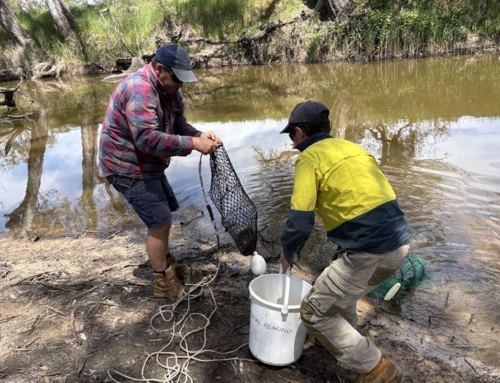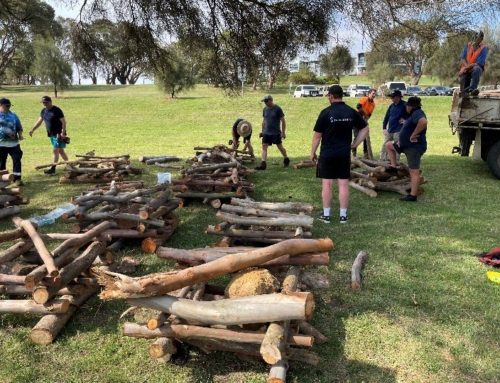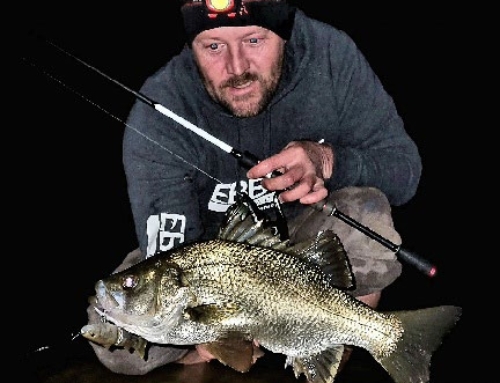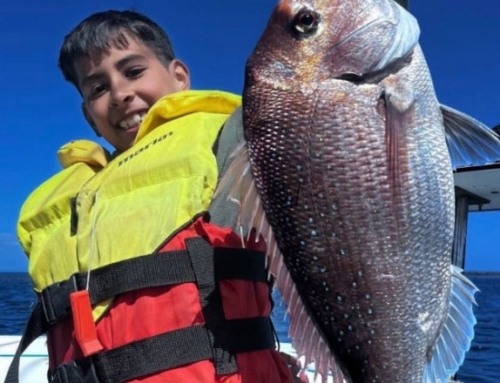 Andrew McGovern shares his favourite estuary and river systems of southern NSW and details what species to expect and how best to fish for them.
Andrew McGovern shares his favourite estuary and river systems of southern NSW and details what species to expect and how best to fish for them.
The far south coast of New South Wales spans from Bateman’s Bay in the north all way to Eden in the south. Within this stretch of coastline are some of the most fertile, productive river and estuarine systems in the country. Having fished the area extensively since he was a kid, Andrew McGovern has experienced some amazing, high-class sports fishing. As difficult as it has been, he has outlined his top five locations in the area and within each identified three consistent fish producing spots.

Bridge over the Clyde River at Bateman’s Bay is the gateway to the far south coast region when travelling down from Sydney.
1. Clyde River – Bateman’s Bay
Bateman’s Bay is 280 km south of Sydney and is the unofficial gateway to the far south coast. The centrepiece to this area is the magnificent Clyde River, which originates from the vast mountain ranges to the north-west. The Clyde is one of the largest rivers on the east coast of Australia that remains undammed with over 32 km of fishable water. This means it is a thriving ecosystem that harbours a plethora of estuary species that include invertebrates all the way up to the piscatorial delights that attracts anglers from far and wide.
a. Nelligen Bridge
There is an excellent concrete boat ramp and pontoon on the western side of river just south of the bridge that is suitable for most trailer boats. There are some good landbased areas near picnic tables that will yield flathead on pilchard pieces and whitebait plus garfish, mullet and the occasional leatherjacket. Be warned it can get crowded during the summer holidays. If fishing from a boat or kayak try working blades and soft plastics around the jetties and wharves that are sprinkled along both shorelines of the river. Bream and estuary perch seek out the cover and protection provided by these man-made structures as do some XOS flathead.
b. Big Island
Bait fishing with strip baits is effective for bream, snapper and tailor. Berley will assist in attracting fish so try anchoring up and lowering baits back into the current as this approach often proves fruitful. The odd mulloway is taken on bait intended for other species so it pays to fish with tackle capable of subduing one of these apex predators. Better than average tailor often frequent this stretch of water from the northern tip of the island running down the western side. If there are tailor present increase your leader size to reduce bite offs.
c. Chinaman’s Point
Inside the channel marker there are some excellent flats worth drifting across for whiting and flathead. Using surface lures on windy days through summer is one of the most productive methods here. Shallow running hardbodied minnows on the end of light fluorocarbon leaders will produce bream. With both lure styles make long casts with the wind and work your lure back across the broken water.
 2. Moruya River – Moruya Heads
2. Moruya River – Moruya Heads
The town of Moruya is a 20 minute drive south of Batemans Bay and about four hours south of Sydney. The Princess Highway bisects the Moruya River right in the heart of town. There are plenty of landbased and boat options up and down the river. On the western side of the bridge there are quite a number of shallow sand and mud flats even at high tide, where boat anglers need to be extra vigilant when moving around the waterway. Flathead and whiting are plentiful across the shallow flats during the warmer months of the year. Drifting squirt worms, prawns and nippers is a highly effective way to catch a feed of fish throughout all sections of the river.
a. Moruya Bridge
The bridge is a popular and reliable location for those wanting to land some flathead using live baits and large soft plastics. November through to April is the prime-time to land a trophy flathead with several fish around the metre mark landed every season. Prawns, worms and whitebait are all productive baits for bream, flathead and tailor. The river has a healthy population of juvenile fish that can make bait fishing difficult, as these small fish are quick to nab a bait. Casting soft plastics tends to produce better quality fish with the bridge pylons a good starting point to work your presentation.
b. Quarry Wharf
There is deep water straight off the wharf where tailor and salmon are common. Casting metal slugs and pre-rigged plastics will account for these pelagics as well as the occasional kingfish. Night fishers are a chance of hooking a prized mulloway when using fresh slab baits. Unfortunately, stingrays and sharks are unwelcome by-catch. There are plenty of yellowtail, garfish and leatherjacket during the day next to the pylons.
c. North Head Drive
Running along the northern shoreline following North Head Drive, anglers can gain easy access straight off the road to cast a line. Prawns, whitebait, live mullet and nippers will give you the best chance at one of the local flathead or bream. For the more adventurous angler there are plenty of sand and mud flats where you can wade and cast surface and sub-surface lures or baits for blackfish, flathead and whiting. You can pump nippers and fish the same area for whiting as the tides builds over the sand and mud. In summer, surface lures worked across the edge of the channel will take bream and whiting. Soft plastics hopped over the many troughs that punctuate the flats is a top method for flathead and flounder.
3. Tuross Lake – Tuross Heads
The township of Tuross Heads is six kilometres off the Princes Highway half way between The Bay and Narooma. The lake itself offers bream, flathead, and whiting as the main target species with mulloway available from October through to February. Tailor, estuary perch, trevally, flounder and tarwhine are other species available. The labyrinth of winding feeder creeks and back waters, mixed with several smaller lake systems make Tuross Lake the ideal location for canoe and kayak anglers.
a. Four Ways
Popular flathead area that produces some nice fish for both bait and lure fishers. Two hours either side of low tide is the most productive phase of the tidal cycle through the summer period. Although flathead are the predominant species captured; blackfish, flounder, bream, garfish and mullet are all readily available.
b. Reedy Island
The south-eastern corner of Reedy’s is a good area to cast suspending minnows for flathead and bream. Try neutral coloured lures such as browns, dark reds, greys and green with stripes or a herringbone pattern across the body. If the water is a little dirty or cool use plenty of pauses during each retrieve to encourage a strike. Working poppers across the shallows from the south-eastern corner moving west is a proven method on whiting.
c. Bumbo Lake
Heading upstream from the highway bridge is Bumbo creek that snakes its way into Bumbo Lake. Where the creek enters the lake is a prime flathead ambush zone on a run-out tide. The lake holds a healthy population of blackfish and flathead with some of the blackfish being the biggest available along this part of the coast. Along with nippers and weed baits, the blackfish will take soft plastics and blades. The best way to target these fish is to work the gaps in the weed with lightly weighted baits and small lures. There is also some excellent snag fishing with hardbodies for bream and flathead in the creek itself.
 4. Wagonga Inlet – Narooma
4. Wagonga Inlet – Narooma
The name Narooma is derived from the local Aboriginal word meaning ‘clear, blue water’. Wagonga Inlet certainly lives up to this apt description regardless of the time of year. Summer is a hugely popular time to fish this inlet as it’s not only one of the more consistent systems on the far south coast, but it offers a variety of fishing options. Breaming around the back water racks, hopping big soft plastics for snapper and mulloway, or flats fishing for bream, flathead, whiting and trevally gives you an idea of what is available.
a. Apex Park and Mill Bay
A high quality boat ramp and jetty can be found near the Apex playgrounds on the northern side of the inlet. Bream can be taken on baits around dusk with some big tailor found lurking in the deeper water after dark near the cleaning table. Blackfish, garfish, flathead and trevally are also common in this area. There is a ‘board walk’ with railing that runs from the park around to Mill Bay. Flathead, trevally and bream can be caught off here but you will need a landing net. During summer the patches of sand will attract for whiting and blackfish.
b. Forsters Bay

Forsters Bay is a good area to troll for tailor with hardbody minnows in the 80 to 120 mm length bracket. Tailor are a year-round prospect but they can fish particularly well from late autumn through winter. Look for bait schools breaking the surface and birds working a concentrated patch of water. Live baiting for one of the monster mulloway that reside in Wagonga is most popular in this bay. Squid and flathead are also regular target species in summer.
c. Honeymoon Bay
This bay is productive for big flathead and mulloway using live mullet, yellowtail and tailor. Position your baits in any deeper sections or near any lumps or bumps on the bottom. Fresh slab baits such as tailor, salmon or garfish fillets will also catch fish but expect to hook up a stingray or two. Soft plastics in the 80 to 120 mm size range are also effective tools to search the water with.
 5. Merimbula Lake – Merimbula
5. Merimbula Lake – Merimbula
Merimbula is situated in the heart of the Sapphire Coast in the far south of the region. For the estuary angler Merimbula Lake offers some superb fishing options. It is best known for its population of large flathead, abundant bream and quality blackfish. Mulloway are also available if you are prepared to chase the tailor schools and work large lures in and around the biggest concentration of fish. Anchoring up and dropping down a live bait or slab of fresh tailor is another proven method for these bronzed warriors of our southern systems. There is an excellent concrete boat ramp located just over the highway bridge on the south-eastern side of the lake. Under the highway bridge produces some great night fishing for tailor, bream and trevally as well as plenty of prawns each month when they run.
a. Top Lake
The Boggy Creek entrance, situated right at the back or western end of the Top Lake is a known big flathead location. Summer is the time to fish here for big flatties using live baits and soft plastics. The run-out tide is the prime-time to drift live baits and hop lures from the shallows into the deeper channel. There are also plenty of racks just south of the creek entrance that hold bream, tarwhine, whiting and flounder using soft baits. The open water, known as the Broadwaters, is often abundant with tailor along with the occasional mulloway. Large plastics working underneath the tailor schools will give you a chance at a prized mulloway.
b. Airport Flats
The Airport Flats are located on the southern shoreline south-east of the main bridge. There is quick, easy access by boat from the concrete ramp just next to the bridge. There are several hundred metres of shallow sand flats behind the Merimbula airstrip that are popular during summer. There is good wading in the warmer months for those not afraid to get their feet wet and shuffle around a stingray or two. Whiting on poppers, bream and flathead on soft plastics, and mullet on live nippers are always keen to get in on the act. Nippers and worms can be pumped from the flats during low tide.
c. Spencer Park and Bottom Section
There is public access through Spencer Park to a vast array of shallow flats and weed beds in the bottom section of the lake. This is a top area to explore if you are landbased. Trevally, tailor, flathead and blackfish are all available here but trevally are my preferred target species here. Standard 3 or 8 cm stickbait soft plastics worked on 1 or 5 g heads is the best method particularly when retrieved across the top of weed beds. Further towards the entrance are the Bar Beach shallows where there is a large expanse of shallow flats running along the eastern shoreline. In summer there is some cracker whiting available on baits and poppers with flathead plentiful from November to April.
There are so many hidden treasures along the south coast of NSW and these five locations only scratch the surface of what is available. The beauty of the area is that the next estuarine and lake system is only a short drive away from the spot you are fishing so if one system has shut down it is quick and easy to move to the next. When planning a fishing trip this summer you can’t go past this region of the country.












